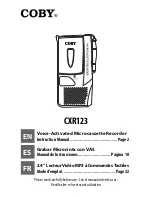
©1999 Hamtronics, Inc.; Hilton NY; USA. All rights reserved. Hamtronics is a registered trademark. Revised: 1/28/00
- Page 9 -
which rests at 5Vdc and goes to
ground temporarily under two condi-
tions. In playback mode, the EOM
line has a short ground pulse (about
15 mSec) at the end of each mes-
sage. If the message runs to the
end of the 20 second recording ca-
pacity, the EOM line goes low to in-
dicate an overflow condition and
stays low if the CE and PD lines are
held low. This condition is reset
when the PD line goes high.
Switching Transistors.
Q3 provides a ground to the key
output at E3 whenever a message is
played back. The base of Q2 is
turned on by Q1 and R1, and re-
mains on for the duration of the
playback. Q2, in turn, biases Q3 on.
Q1 initially is turned on by a
ground pulse from S1 or the Play-
back Control line. It is held on by
voltage applied through R4 and R5
from the audio output of U1, which
has dc bias only during playback. At
the end of the message, the EOM
ground pulse from U1 pin 25 turns
off Q1.
During record, pressing S2
grounds the P/R pin 27, which puts
U1 in record mode instead of play-
back. S1 must also be pressed at
the same time or the Playback Con-
trol line must hold the S1 circuit at
ground to make the ic run during
record. Because their is no output
on the audio output pins (14 & 15)
during record, Q1 does not latch on
as it does in playback mode.
Switching transistors Q4 and Q5
act as a buffer for the Record Con-
trol input from the Time Out led cir-
cuit on the COR-5 board. When the
COR-5 requests a record session,
Q5 grounds the S2 record circuit as
if S2 was pressed.
Power Supply Circuit.
The acceptable range of operat-
ing voltages is +4.75 to +5.25 Vdc.
Current drain normally is about 4
mA at idle and 22 mA in playback
mode.
It is very important, though, to
protect the entire board from voltage
transients and reverse polarity,
which will cause damage. If the
DVR-3 is powered from the COR-5,
as is normal, then you don't need to
worry about transients. But if you
use a separate power source, be
careful, especially if any relays are
powered from the same line. Any
relay coils or other inductive devices
must have diodes connected across
them to absorb transients generated
when current to the coil is switched
off.
PARTS LIST.
Ref Desig Description (marking)
C1-C4
0.1
µ
f monolithic
(104)
C5
.001
µ
f
(102, 1nM, or 1nK)
C6
0.1
µ
f monolithic
(104)
C7
not assigned
C8-C10
0.1
µ
f monolithic
(104)
C11
1
µ
f electrolytic
C12
4.7
µ
f electrolytic
C13
47
µ
f electrolytic
CR1
not assigned
CR2
1N4148 switching diode
Q1
2N3904
Q2
2N3906
Q3
2N3904
Q4
2N3906
Q5
2N3904
R1-R5
47k
R6
100k
R7
15k
R8
22k or 20k pot
R9
47k
R10
510k
R11
150k
R12
4.7k
R13
47k
R14
100k
S1-S2
pushbutton switch, spst
U1
ISD-1020A recorder ic
Z1
ferrite bead, prestrung





























